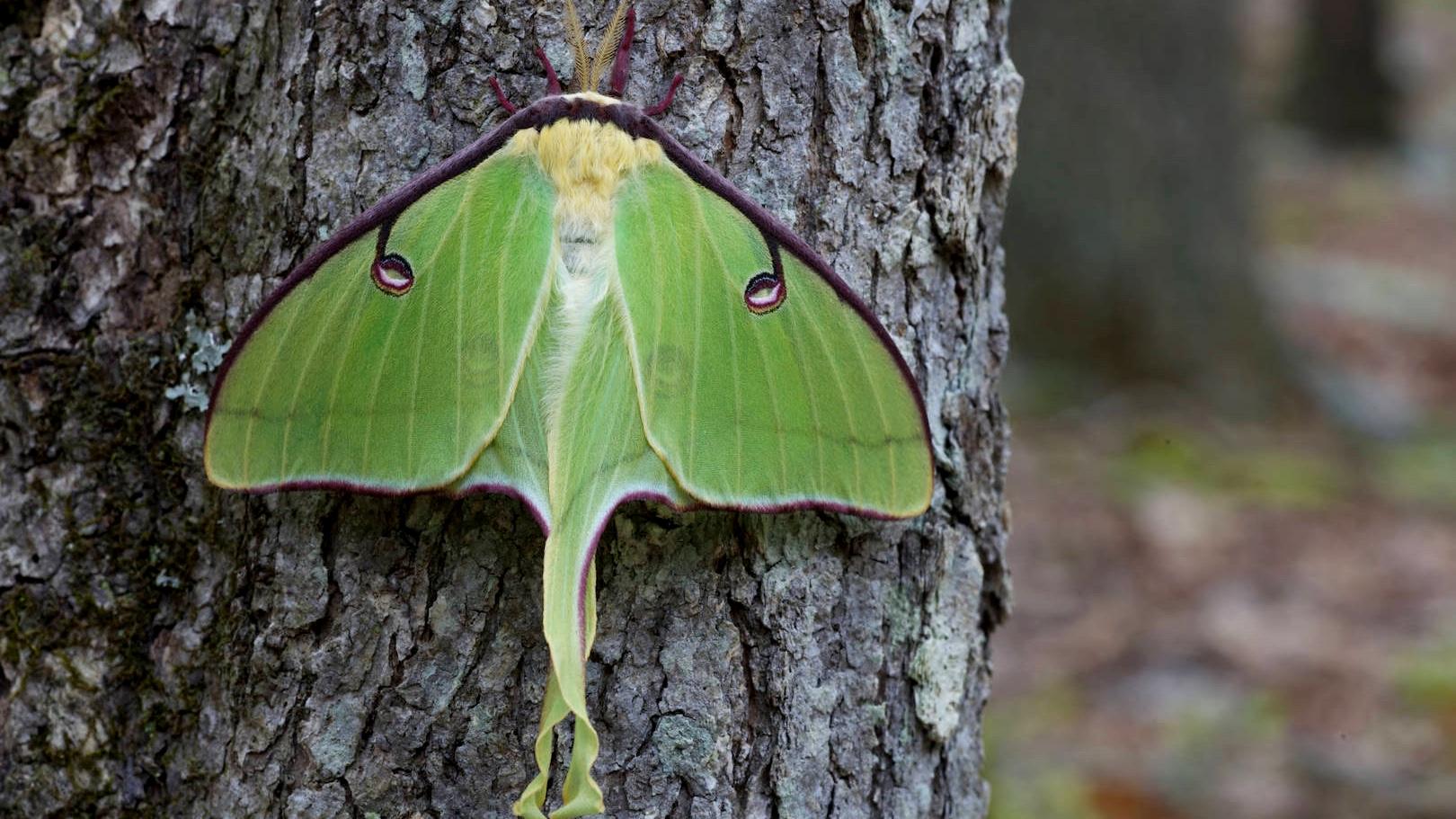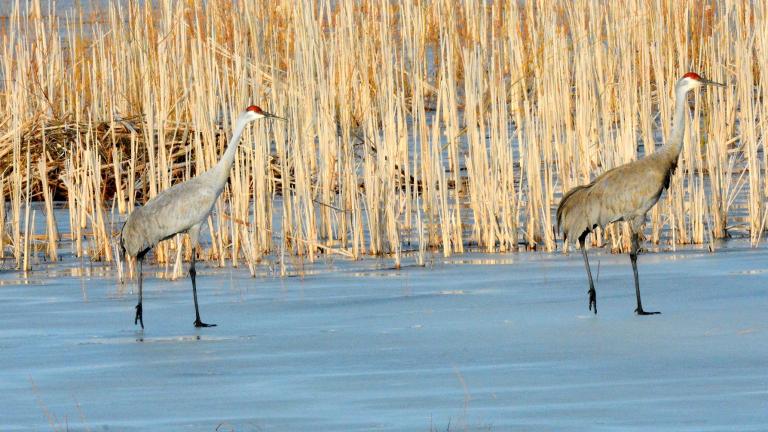When most people think of moths, if they think of them at all, chances are they picture a smallish, nondescript bug fluttering around a porch light at night. Even biologists have a tendency to dismiss moths as drab “LBJs” — a nickname standing for “little brown jobs,” meaning ubiquitous and undistinguishable — overshadowed by their more glamorous kin, the butterfly.
“They’re kind of ignored,” Jim Steffen, emeritus senior ecologist with the Chicago Botanic Garden, said of moths’ lack of appeal.
It’s time to pay attention.
Of the nearly 180,000 species within the order of Lepidoptera, fewer than 20,000 are butterflies and skippers. The rest of the 150,000-plus species are moths — and that may be a lowball estimate, with potentially hundreds of thousands more species as yet unnamed. Moths are found on every continent except Antarctica, with Illinois home to more than 2,000 moth species, compared with just 150 butterfly species.
“If you’re looking for them, you find them everywhere,” said Steffen, who’s personally identified 665 moth species at McDonald Woods, 100 acres of oak forest undergoing restoration in Glencoe.
The thing is, there aren’t a whole lot of people looking. When moths come out to play, most folks are sleeping.
What we’re missing out on, said Allen Lawrance, an entomologist at the Peggy Notebaert Nature Museum, is moths’ incredible diversity.
While some are indeed brown and as small as gnats (known as microlepidoptera, often identifiable only through DNA sampling) plenty are colorful and even quite glamorous. Others have wingspans approaching a foot, like Australia’s mighty Hercules moth, which has the largest wing surface area of any insect. There’s an entire group of moths that mimics the looks of bees and wasps to avoid being eaten. And another bunch, leafminers, that spend their entire caterpillar phase living within the layers of a single leaf. Not on a leaf, it bears repeating, but inside.
There are moths without mouths, moths with clear wings, moths that hover like hummingbirds and moth caterpillars that spin the silkiest of silk. If only they would show up during the day, people might fall in love.
 Cecropia moths, mating. Moth caterpillars are vital source of food for birds. (Courtesy of U.S. Fish and Wildlife Service)
Cecropia moths, mating. Moth caterpillars are vital source of food for birds. (Courtesy of U.S. Fish and Wildlife Service)
National Moth Week, running this year through July 25, was created in 2012 to raise the profile of these creatures, which are woefully underappreciated and misunderstood in large part because of their nocturnal behavior. In moths’ case, human ignorance of what we can’t see has far-reaching ecological repercussions.
Moths are often mistakenly lumped together under the category of “pest,” and while it’s true that some are destructive, on the whole they’re far more beneficial to the planet than they are harmful.
“They kind of do everything,” said Lawrance.
Among their talents, moths are excellent pollinators, second perhaps only to bees. But their greatest service to an ecosystem is the role moths play in the food web.
“Without moths, we lose a really important food source for birds and bats,” Lawrance said.
Research has estimated that 90% of a young songbird’s diet consists of moth caterpillars. One study determined that a lone family of chickadees, with four or five young chicks, can consume 7,000 to 9,000 moth caterpillars in a single nesting season, said Steffen.
Yet moth populations have suffered steep declines, by as much as 60%, he said, due to the loss of native vegetation.
A number of moth species are as tied to specific native host plants as monarch butterflies are to milkweed. These include the raspberry-colored leadplant flower moth, which relies on leadplant, once commonly found in prairie landscapes. The yucca moth is another example, incapable of surviving without the yucca plant and vice versa.
“Without those plants, you can’t have that moth,” Lawrance said. “They’re really dependent on high-quality habitat.”
 As colorful and glamorous as a butterfly, the luna spicebush moth. (Courtesy of U.S. Fish and Wildlife Service)
As colorful and glamorous as a butterfly, the luna spicebush moth. (Courtesy of U.S. Fish and Wildlife Service)
The plight of some moths is even more dire than the monarch’s because they’re not migratory or particularly mobile, especially the smaller species.
Where monarchs are considered “disturbance tolerant” in that they can locate and live off a patch of milkweed planted, behind, say, a Walmart store, many moths have restricted ranges, Steffen explained.
“You can’t take a plant out of its habitat and expect them to find it,” he said. “We can’t create what we’ve destroyed. It’s better not to have destroyed it in the first place.”
Ultimately, the loss of native vegetation leads to the loss of moths leads to the loss of birds leads to loss after loss.
“It’s all tied together, they’re all connected,” said Steffen. “If people knew how important moths are, they would give them more credit. So much of the rest of the ecosystem depends on them, the rest would collapse without them.”
MOTH TO A FLAME
 A hawkmoth. (Ian Lindsay / Pixabay)
How’s this for irony: Considering that moths are generally nocturnal creatures, the one thing most people know about the insects is that they’re attracted to light, like, well, a moth to a flame.
A hawkmoth. (Ian Lindsay / Pixabay)
How’s this for irony: Considering that moths are generally nocturnal creatures, the one thing most people know about the insects is that they’re attracted to light, like, well, a moth to a flame.
Or are they?
Nobody really knows why moths are drawn to lights, said Jim Steffen.
But one widely held theory is that moths seem to use light to navigate, in the sense that the starry or moonlit sky is brighter than the ground. Artificial light causes them to adjust their flight pattern, and ultimately disorients them as they wind up spiraling, Steffen said.
For this reason, among others, light pollution is contributing to declines in moth populations. Studies have shown that while urban moths appear to have a reduced attraction to light sources, they’re also less mobile as a consequence, which affects their ability to mate and forage for food.
Contact Patty Wetli: @pattywetli | (773) 509-5623 | [email protected]








